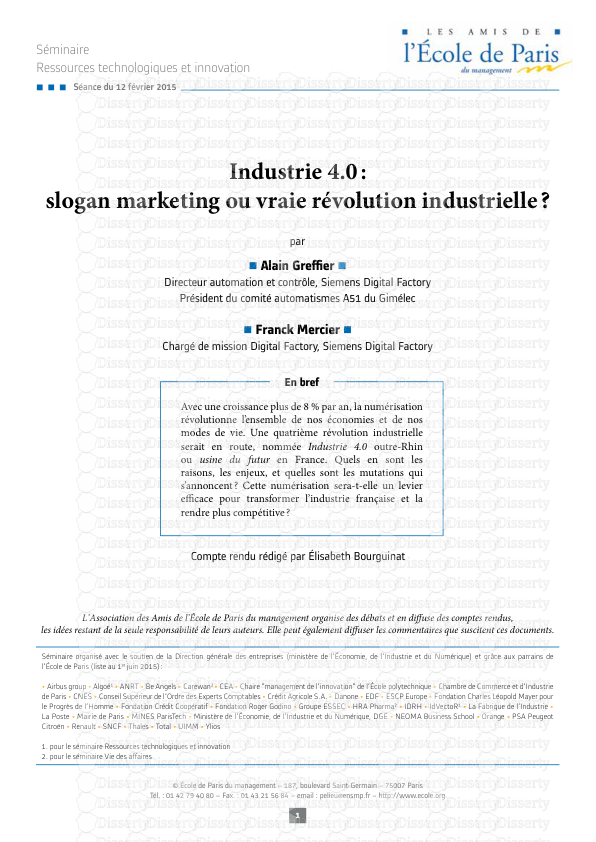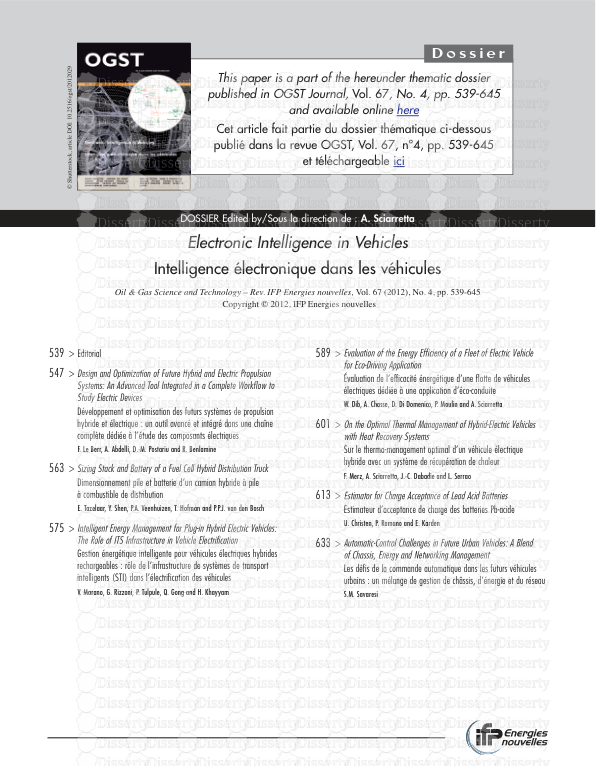This paper is a part of the hereunder thematic dossier published in OGST Journa
This paper is a part of the hereunder thematic dossier published in OGST Journal, Vol. 67, No. 4, pp. 539-645 and available online here Cet article fait partie du dossier thématique ci-dessous publié dans la revue OGST, Vol. 67, n°4, pp. 539-645 et téléchargeable ici D o s s i e r DOSSIER Edited by/Sous la direction de : A. Sciarretta Electronic Intelligence in Vehicles Intelligence électronique dans les véhicules Oil & Gas Science and Technology – Rev. IFP Energies nouvelles, Vol. 67 (2012), No. 4, pp. 539-645 Copyright © 2012, IFP Energies nouvelles 539 > Editorial 547 > Design and Optimization of Future Hybrid and Electric Propulsion Systems: An Advanced Tool Integrated in a Complete Workflow to Study Electric Devices Développement et optimisation des futurs systèmes de propulsion hybride et électrique : un outil avancé et intégré dans une chaîne complète dédiée à l’étude des composants électriques F. Le Berr, A. Abdelli, D.-M. Postariu and R. Benlamine 563 > Sizing Stack and Battery of a Fuel Cell Hybrid Distribution Truck Dimensionnement pile et batterie d’un camion hybride à pile à combustible de distribution E. Tazelaar, Y. Shen, P.A. Veenhuizen, T. Hofman and P.P.J. van den Bosch 575 > Intelligent Energy Management for Plug-in Hybrid Electric Vehicles: The Role of ITS Infrastructure in Vehicle Electrification Gestion énergétique intelligente pour véhicules électriques hybrides rechargeables : rôle de l’infrastructure de systèmes de transport intelligents (STI) dans l’électrification des véhicules V. Marano, G. Rizzoni, P. Tulpule, Q. Gong and H. Khayyam 589 > Evaluation of the Energy Efficiency of a Fleet of Electric Vehicle for Eco-Driving Application Évaluation de l’efficacité énergétique d’une flotte de véhicules électriques dédiée à une application d’éco-conduite W. Dib, A. Chasse, D. Di Domenico, P. Moulin and A. Sciarretta 601 > On the Optimal Thermal Management of Hybrid-Electric Vehicles with Heat Recovery Systems Sur le thermo-management optimal d’un véhicule électrique hybride avec un système de récupération de chaleur F. Merz, A. Sciarretta, J.-C. Dabadie and L. Serrao 613 > Estimator for Charge Acceptance of Lead Acid Batteries Estimateur d’acceptance de charge des batteries Pb-acide U. Christen, P. Romano and E. Karden 633 > Automatic-Control Challenges in Future Urban Vehicles: A Blend of Chassis, Energy and Networking Management Les défis de la commande automatique dans les futurs véhicules urbains : un mélange de gestion de châssis, d’énergie et du réseau S.M. Savaresi © Shutterstock, article DOI: 10.2516/ogst/2012029 Design and Optimization of Future Hybrid and Electric Propulsion Systems: An Advanced Tool Integrated in a Complete Workflow to Study Electric Devices F . Le Berr, A. Abdelli, D.-M. Postariu and R. Benlamine IFP Energies nouvelles, 1-4 avenue de Bois-Préau, 92852 Rueil-Malmaison Cedex - France e-mail: fabrice.le-berr@ifpen.fr - abdenour.abdelli@ifpen.fr Résumé — Développement et optimisation des futurs systèmes de propulsion hybride et électrique: un outil avancé et intégré dans une chaîne complète dédiée à l'étude des composants électriques — Le recours à l’électrification pour réduire les émissions de gaz à effet de serre dans le domaine du transport est désormais reconnu comme une solution pertinente et d’avenir, très étudiée par l’ensemble des acteurs du domaine. Dans cet objectif, un outil d’aide au dimensionnement et à la caractérisation de machines électriques a été développé à IFP Energies nouvelles. Cet outil, appelé EMTool, est basé sur les équations physiques du domaine et est intégré à un ensemble d’outils de simulation dédiés à l’étude des groupes motopropulseurs électrifiés, comme les outils de modélisation par éléments finis ou les outils de simulation système. Il permet d’étudier plusieurs types de topologies de machines électriques : machines synchrones à aimants permanents à flux radial ou axial, machines asynchrones, etc. Ce papier présente les grands principes de dimensionnement et les principales équations intégrées à l’EMTool, les méthodes pour évaluer les performances des machines dimensionnées ainsi que les validations effectuées sur une machine existante. Enfin, le positionnement de l’EMTool dans la chaîne d’outils et des exemples d’applications sont exposés, notamment en couplant l’outil à des algorithmes d’optimisation avancés ou à la modélisation par éléments finis. Abstract — Design and Optimization of Future Hybrid and Electric Propulsion Systems: An Advanced Tool Integrated in a Complete Workflow to Study Electric Devices — Electrification to reduce greenhouse effect gases in transport sector is now well-known as a relevant and future solution studied intensively by the whole actors of the domain. To reach this objective, a tool for design and characterization of electric machines has been developed at IFP Energies nouvelles. This tool, called EMTool, is based on physical equations and is integrated to a complete workflow of simulation tools, as Finite Element Models or System Simulation. This tool offers the possibility to study several types of electric machine topologies: permanent magnet synchronous machine with radial or axial flux, induction machines, etc. This paper presents the main principles of design and the main equations integrated in the EMTool, the methods to evaluate electric machine performances and the validations performed on existing machine. Finally, the position of the EMTool in the simulation tool workflow and application examples are presented, notably by coupling the EMTool with advanced optimization algorithms or finite element models. Oil & Gas Science and Technology – Rev. IFP Energies nouvelles, Vol. 67 (2012), No. 4, pp. 547-562 Copyright © 2012, IFP Energies nouvelles DOI: 10.2516/ogst/2012029 Electronic Intelligence in Vehicles Intelligence électronique dans les véhicules D o ss i e r Oil & Gas Science and Technology – Rev. IFP Energies nouvelles, Vol. 67 (2012), No. 4 548 ABBREVIATIONS CFPM Concentrating Flux Permanent Magnet EM Electric Motor EV Electric Vehicle FEM Finite Element Model GHG Greenhouse Gases HEV Hybrid Electric Vehicle ICE Internal Combustion Engine IM Induction Machine IPM Internal Permanent Magnet MTPA Maximum Torque Per Ampere PM Permanent Magnet PMBL Permanent Magnet Brushless PMBLDC DC Permanent Magnet Brushless PMSM Permanent Magnet Synchronous Motor INTRODUCTION Fighting against the planet global warming, by limiting or even reducing the emissions of greenhouse effect gases (GHG) and notably the CO2 emissions, will certainly be one of the major challenges of the next decades. The transport sector is recognized as one of those major responsible of these GHG. This sector has been in a considerable expansion during the last fifty years, notably due to the increase of human activity and mobility demand. In this context, it seems to be difficult to reduce CO2 emissions, except by improving energy efficiency of transport systems. For instance, this objective motivates all the developments on the well known Internal Combustion Engine (ICE) which is now becoming a remarkable innovative and efficient system. Nevertheless, to go further and to keep on improving global efficiency of the global powertrain, it is time to consider a breakthrough: the transport electrification. By introducing new perspectives and notably a new source of energy, electrification seems to be an interesting alternative way to continue the progress on the powertrain efficiency. Nevertheless, electrification introduces new chal- lenges to face to: new degrees of freedom to optimize and thus an increase in powertrain complexity, a new type of energy to manage with new problems of efficiency, new challenges in terms of reliability, security and cost as evidence. In a context where industrial world is affected by successive economic and financial crises, engineers have to find cost effective solutions to keep on progress on system efficiency improvement and one of these solutions consists in developing and extending numerical simulation in order to manage system complexity while limiting development cost and duration. The objective of this paper is to present a tool dedicated to the study of electrification notably for the transport sector. After a first explanation of the motivations to develop such a design and modeling tool to help engineers to face to the new challenges of transport electrification, this paper presents the global methodology used in this tool dedicated to the pre-sizing and characterization of the electric machines. A validation case is presented by comparison with experimental results obtained on an Electric Motor of the automotive sector. At the end of the paper, some concrete application examples are presented to illustrate the interesting potential of the tool to support the specification, the optimization and the management of the complex electrified powertrain envisaged in the transport sector. 1 CONTEXT 1.1 The Complex Issue of Transport Electrification It is now an acknowledge fact that human activity and notably transport sector is one of those major responsible of the increase of the global warming. Indeed, the transport sector is the second-largest sector in terms of CO2 emissions, just after the sector of generation of electricity and heat. The transport sector represented 22% of global CO2 emissions in 2008 in the world (Fig. 1), [1]. In France for instance, the transport sector represents more than 34% of the whole CO2 emitted by the country [2]. Taken into account this context and to tackle the difficult challenge of global warming, the whole transport sector is now focused one important objec- tive: reducing CO2 emissions by improving energy efficiency. The different transport sectors have decided to take measures and incentives to limit or reduce the CO2 emissions. uploads/Industriel/ design-and-optimization-of-future-hybrid-and-electric-propulsion-systems-an-advanced-tool-integrated-in-a-complete-workflow-to-study-electric-devices.pdf
Documents similaires










-
64
-
0
-
0
Licence et utilisation
Gratuit pour un usage personnel Attribution requise- Détails
- Publié le Mai 19, 2021
- Catégorie Industry / Industr...
- Langue French
- Taille du fichier 2.8031MB


